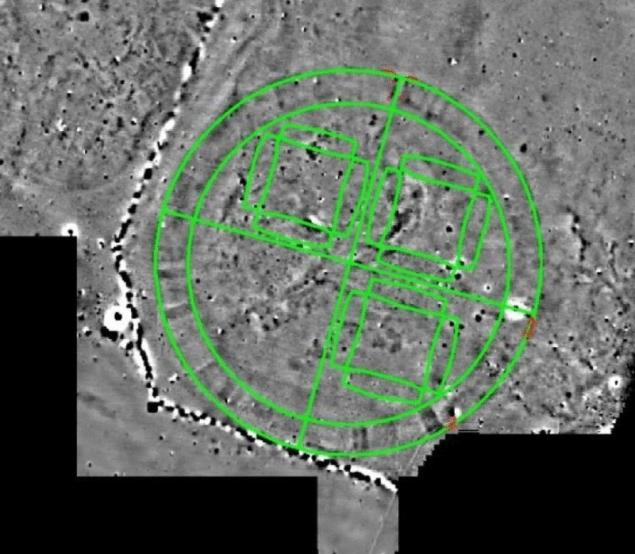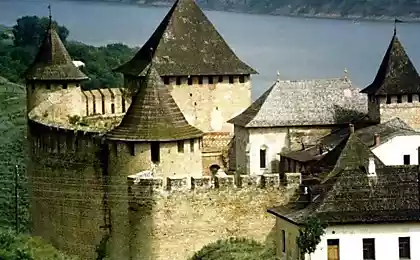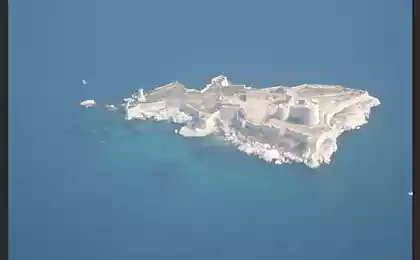605
In Denmark opened a new Viking fortress
Round the castle could be built during the reign of the king of Denmark and Norway Harald I Bluetooth or his son, Sven I Beloborodova, who won England.
Archaeologists from Aarhus University and the Danish centre for the study of castles has discovered a previously unknown Viking fortress. It is located West of the city of køge (Zealand island, Denmark).

The fortress has the shape of a circle with a diameter of approximately 145 meters. It is surrounded by a shaft width of about 10 meters around the sides there are four gates. Interior courtyard symmetrically divided into four quarters. Inside, probably, were the "long houses" of the Vikings.
The external signs of a fortress similar to the famous castle of Trelleborg, built by king Harald I Bluetooth around the year 980 ad, it is Possible that the new monument also dates from this time. According to another version, the fortress could be built by the son of Harald I – Sven I Vilamartin. According to historians, Sven could use a circular fortress for military training or barracks, which were collected and prepared troops for the invasion of England.
"The new circular Viking fortress discovered in Denmark for the first time in 60 years," said Hill Nanna (Nanna Holm), an archaeologist and curator of the Danish centre for the study of locks. Her colleague on the expedition, Professor of medieval archaeology at Aarhus University, søren Sindbaek (Søren Sindbæk) adds:
"The opening of the new Viking fortress is a unique opportunity to learn more about the battles and wars of the Vikings, and gives us a new opportunity to explore the most famous of our Viking monuments."
The fortress was opened as a result of new, precise laser measurements of the landscape. As a result, the archaeologists were able to identify a clear circular shape, hidden underneath an almost imperceptible hill. To test their assumptions, Danish archaeologists have turned to the experts in archaeological Geophysics from the University of York.
"Measuring small variations of the magnetic field allows the soil to reveal the ancient pits or shafts, not destroying them. This technique gave us a surprisingly detailed image of the fortress in just a few days. So we knew exactly where to lay the research trenches to learn about the castle so much more, as far as possible," explained søren Sindbaek.
Nanna Hill emphasizes that the fortress was a military object and was probably the seat of hostilities. She has no doubt that the fortress belongs to the Viking era:
"Fortress, built in the same way as this, only built in the Viking age, and the burnt logs, discovered in the gate, allow us to determine the date using the radiocarbon method and dendrochronology. We have already sent samples for analysis, and results will be available within a few weeks. The date is very important. If we can establish exactly when the fortress was built, it will help us to understand the historical events with which it was connected".
Circular fortress of the Vikings, probably the most famous historical monuments in Denmark. They attract tourists from all over the world, and at one time led to a revision of some aspects of Danish history. The new discovery may also be an important piece of the historical puzzle.
"Fortification of the Viking age may shed light on the links between Zealand, ancient Denmark and the Jelling dynasty. In the same way as will enable us to learn more about the period during which Denmark became Denmark," says Nanna Holm.
Jelling dynasty – the oldest in Europe. The first is considered the king of Denmark, Gorm the Old (910-e–958? .) He ruled from Jelling, located on the Jutland Peninsula, hence the name of the dynasty.
Harald I Bluetooth (930-e–986, rules 958-986.) was the son of Gorm the Old. According to the legend, earned the nickname from the dark color of the teeth. When Harald I of Denmark officially converted to Christianity. In 976 king was in Alliance with Earl Haakon II defeated the Mighty monarch of Norway Harald II Gray Skin. After this the Earl became the de facto king of Norway, although for some time he recognized the supremacy of Harald I Bluetooth.
In the year 983, in Alliance with obodrite (tribal Union polabian Slavs) Harald Bluetooth ousted the Germans from the southern part of Denmark. It is assumed that during the war with the Germans, the king built a few circular fortresses in Denmark and skåne Peninsula (South of Sweden).
Sven I Vilebody managed to unite under his rule not only Denmark (986-1014) and Norway (986-995, 1000-1014), but England (although for a short time: 1013-1014). According to some sources, Sven was the illegitimate son of Harald I. He was baptized, but according to some testimonies remained a pagan, and may have achieved power in the fight with his father.
In the year 1000 the combined Danish-Swedish fleet defeated the king of Norway Olaf Tryggvason. This victory allowed Sven I regain control of Norway.
Perhaps Sven was behind the raids on England in the first decade of the XI century. Know exactly what it is in 1013 invaded England, took a lot of settlements and besieged London. At the end of 1013 English king Ethelred II fled to Normandy and London capitulated. Sven Beloborodova proclaimed king.
However, in early February, 1014 years, the king died. According to the legend immediately after the occupation of the English throne, he ordered to collect more taxes, including dare "to compel a significant tribute from Edmundsbury of the monastery, where lie the mortal remains of St. Edmund". The monks asked to see the monastery from tax, but Sven threatened to burn the monastery to kill its inhabitants and questioned the sanctity of Edmund. Soon after, he felt a sharp pain in the stomach and died in terrible agony.
Egor Antonov on materials Aarhus University, The Telegraph
Source: nkj.ru
Archaeologists from Aarhus University and the Danish centre for the study of castles has discovered a previously unknown Viking fortress. It is located West of the city of køge (Zealand island, Denmark).

The fortress has the shape of a circle with a diameter of approximately 145 meters. It is surrounded by a shaft width of about 10 meters around the sides there are four gates. Interior courtyard symmetrically divided into four quarters. Inside, probably, were the "long houses" of the Vikings.
The external signs of a fortress similar to the famous castle of Trelleborg, built by king Harald I Bluetooth around the year 980 ad, it is Possible that the new monument also dates from this time. According to another version, the fortress could be built by the son of Harald I – Sven I Vilamartin. According to historians, Sven could use a circular fortress for military training or barracks, which were collected and prepared troops for the invasion of England.
"The new circular Viking fortress discovered in Denmark for the first time in 60 years," said Hill Nanna (Nanna Holm), an archaeologist and curator of the Danish centre for the study of locks. Her colleague on the expedition, Professor of medieval archaeology at Aarhus University, søren Sindbaek (Søren Sindbæk) adds:
"The opening of the new Viking fortress is a unique opportunity to learn more about the battles and wars of the Vikings, and gives us a new opportunity to explore the most famous of our Viking monuments."
The fortress was opened as a result of new, precise laser measurements of the landscape. As a result, the archaeologists were able to identify a clear circular shape, hidden underneath an almost imperceptible hill. To test their assumptions, Danish archaeologists have turned to the experts in archaeological Geophysics from the University of York.
"Measuring small variations of the magnetic field allows the soil to reveal the ancient pits or shafts, not destroying them. This technique gave us a surprisingly detailed image of the fortress in just a few days. So we knew exactly where to lay the research trenches to learn about the castle so much more, as far as possible," explained søren Sindbaek.
Nanna Hill emphasizes that the fortress was a military object and was probably the seat of hostilities. She has no doubt that the fortress belongs to the Viking era:
"Fortress, built in the same way as this, only built in the Viking age, and the burnt logs, discovered in the gate, allow us to determine the date using the radiocarbon method and dendrochronology. We have already sent samples for analysis, and results will be available within a few weeks. The date is very important. If we can establish exactly when the fortress was built, it will help us to understand the historical events with which it was connected".
Circular fortress of the Vikings, probably the most famous historical monuments in Denmark. They attract tourists from all over the world, and at one time led to a revision of some aspects of Danish history. The new discovery may also be an important piece of the historical puzzle.
"Fortification of the Viking age may shed light on the links between Zealand, ancient Denmark and the Jelling dynasty. In the same way as will enable us to learn more about the period during which Denmark became Denmark," says Nanna Holm.
Jelling dynasty – the oldest in Europe. The first is considered the king of Denmark, Gorm the Old (910-e–958? .) He ruled from Jelling, located on the Jutland Peninsula, hence the name of the dynasty.
Harald I Bluetooth (930-e–986, rules 958-986.) was the son of Gorm the Old. According to the legend, earned the nickname from the dark color of the teeth. When Harald I of Denmark officially converted to Christianity. In 976 king was in Alliance with Earl Haakon II defeated the Mighty monarch of Norway Harald II Gray Skin. After this the Earl became the de facto king of Norway, although for some time he recognized the supremacy of Harald I Bluetooth.
In the year 983, in Alliance with obodrite (tribal Union polabian Slavs) Harald Bluetooth ousted the Germans from the southern part of Denmark. It is assumed that during the war with the Germans, the king built a few circular fortresses in Denmark and skåne Peninsula (South of Sweden).
Sven I Vilebody managed to unite under his rule not only Denmark (986-1014) and Norway (986-995, 1000-1014), but England (although for a short time: 1013-1014). According to some sources, Sven was the illegitimate son of Harald I. He was baptized, but according to some testimonies remained a pagan, and may have achieved power in the fight with his father.
In the year 1000 the combined Danish-Swedish fleet defeated the king of Norway Olaf Tryggvason. This victory allowed Sven I regain control of Norway.
Perhaps Sven was behind the raids on England in the first decade of the XI century. Know exactly what it is in 1013 invaded England, took a lot of settlements and besieged London. At the end of 1013 English king Ethelred II fled to Normandy and London capitulated. Sven Beloborodova proclaimed king.
However, in early February, 1014 years, the king died. According to the legend immediately after the occupation of the English throne, he ordered to collect more taxes, including dare "to compel a significant tribute from Edmundsbury of the monastery, where lie the mortal remains of St. Edmund". The monks asked to see the monastery from tax, but Sven threatened to burn the monastery to kill its inhabitants and questioned the sanctity of Edmund. Soon after, he felt a sharp pain in the stomach and died in terrible agony.
Egor Antonov on materials Aarhus University, The Telegraph
Source: nkj.ru
Serious in the Funny, Criticism in the Social Caricature of Pavel Kuchinsky
Men and women choose the house different























